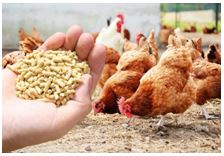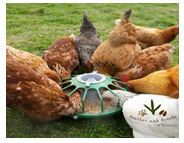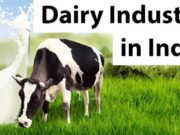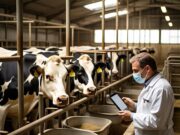
INTRODUCTION
Poultry sector in India has seen a paradigms shift in both its structure and operation. Initially due to the religious sentiments of people of India poultry was considered a backyard based activity by a small stratum of society. But with the change of attitude of the masses towards the poultry products, people began to see poultry products as a cheap and readily available source of protein. Poultry industry has emerged as the fastest-growing segment not only in the livestock sector but also in the agriculture sector as a whole. The sector further flourished with the development of various high-producing lines and strains. The present population of poultry birds in India as per the 20th Livestock Census is 851.81 million that has increased by 16.81% as compared to the previous livestock census. The production of eggs and broilers has been increasing at the rate of 8-10 percent per annum.
Poultry feeding is one of the most important aspects of the poultry industry and is itself developing as a separate enterprise that is related to exclusively poultry feeding. The reason is that in poultry farming the feed cost accounts for the 65-70 percent of the total farm expenses. Thus constant efforts are being made to reduce this cost so that the poultry production can become more economical and the farmers can get more profit. In this avenue there is a need to further improve the scientific knowledge so that the locally available low-cost feed resources can be utilized in the feeding of poultry birds.
COST EEFECTIVE FEED PRODUCTION
The cost effective feed production will be a boon to the small and marginalised poultry farmers or the backyard poultry farmers. Attempts to use locally available cheap by-products may help end consumers by lowering feed costs, which in turn can lower the total cost of production of meat and eggs, making them more affordable in rural India. The poultry being a monogastric competes directly with the human population in terms of the food resources. Maize and soya bean are the major cost determining factor for the poultry feed. With the ever increasing demand of human population for these ingredients, the supply of such feed ingredients are not adequate. Current demand for poultry feed in India is estimated between 25 to 29 million tonne in 2020 and is expected to increase to 39 million tonne in 2025 at the current growth rate of about6% in poultry production. Therefore the search for the low-cost alternatives for decreasing the cost of feed has become inevitable.
| Nutrients | Sources |
| Carbohydrates | Cereals, cereal by-products, animal fats, vegetable oils |
| Protein | Plant protein (by-products of oilseed crops), animal protein (meat, bone, feather meal, etc.) |
| Mineral | Calcium supplements (limestone, shell grit), calcium and phosphorous supplements (CaHPO4 , bone meal), trace minerals (Cu, Fe, Mn, Zn, Co, I, Mo, etc.), and sodium sources (NaCl, NaHCO3 ) |
| Vitamins | Vitamin premixes |
| Amino acids | Lysine, methionine, therionine |
| Feed additives | Enzymes, antibiotics, etc. |
Feed formulation is key aspect and necessitates a good understanding of the following points:
- Dietary nutrient requirements of the class of poultry (layers, broilers, etc.).
- Feed ingredients in terms of nutrient composition.
- Cost of feed ingredients.
- Availability of feed ingredients.
An approach that can be explored is developing specific strains of poultry that have a low feed requirement and that give a faster rate of production. The less the time required by the bird to grow to its full potential the less is the feed requirement. But this approach has its limitation as it cannot reduce the feed cost significantly and the time required by this method is more. So an alternative is to reduce the cost of feed by use of unconventional feed sources or employ such feed processing aid that the residual part of the feed can be utilized as a dietary source.
For the formulation of a cost-effective feed for the layers and broilers, we have to first identify the alternative resources that can be used for the feeding of these birds. The prerequisite of such ingredients is that they should not be a part of human consumption in any form. The other condition to be satisfied is that the ingredient should not possess a harmful effect either in long term or short term on the bird and also no effect should be observed on the final consumer of the produce. The ingredients should be tested for their effect on the production performance of the bird before their incorporation in the feed formulation.
Due to the large gap of demand and availability of feedstuffs a solution that can be looked upon is by utilization of structural carbohydrates and phytate phosphorous. With the growing demand for the reduction in the cost of feed a shift of focus is required from formulating a new feed formulation to how to utilize the existing formulations efficiently. Many feed components, such as B-glucans, pentosans, mannans, cellulose, lignin, and phytic acid, are indigestible to chickens. These non-digestible feed components typically cause digestive stress in chickens, resulting in decreased nutrient utilisation and moist litter issues. The addition of feed enzymes could significantly alleviate these issues.
A large part of feed cost can be reduced if there is a shift from the traditional protein and energy sources to the sources that are produced as by product by humans. The utilization of agro-industrial by-products and unconventional feedstuff can significantly reduce the feed cost. But before incorporation of such ingredients into the commercial broiler and layer feed on a regular basis, their effects and influence on the production performance of these ingredients need to be established. If the unconventional feeds have some sort of anti-nutritional factor that pose a threat to the production performance of the birds so a methodology that is economically feasible should be employed to deactivate the anti-nutritional factors. Inactivating such anti-nutritional factors increase the nutrient availability of such ingredients and lead to an efficient utilization of these products. The nutritional value of a number of maize and soybean meal replacers has been investigated, and despite their promise, their use in practical formulations is minimal due to limits imposed by many anti-nutritional, technical, and socioeconomic issues. These limits must be addressed by the feed industry with the assistance of scientists, planners, and policymakers.

COST EEFECTIVE FEEDING PRACTICES
A significant improvement in the utilization of feed and thereby reducing the cost of feed is the proper processing of feed. Processing is the treatment of materials during or soon after mixing with the goal of providing a balanced diet suited for poultry feeding. This method generally involves some degree of material grinding, which enhances admixture consistency, gives particles of a size thought to be suitable for the target group, and may make nutrients more available for digestion in the birds. Following that, the feed may be heat-treated or pelleted.
As the poultry production systems either layer or broiler are broadly divide into three categories i.e. commercial, semi-commercial and the backyard or scavenging system. There is a wide range of alternative feedstuffs available for the feeding of poultry birds in all three systems. But the greatest potential for utilization of these feedstuffs is in the traditional scavenging and semi-commercial systems. Because just a portion of the feed demand is obtained from commercial compounders under the semi-commercial system, there is room for on-farm mixing or dilution of purchased feeds with locally available, alternative feedstuffs. Alternative feedstuffs, which are locally available, can be utilised to supplement the scavenging feed base in low-input family poultry systems.
The main energy source for the poultry industry is the maize grain. But the production of maize grain has not increased at par with the livestock and poultry sector growth. So as an alternative to reduce the demand of maize in the poultry feed different combinations of maize can be tried with other low cost cereals such as pearl millet, finger millet and sorghum. The incorporation of these grains and oilseed residue has proved to be beneficial for the poultry industry development. Another benefit with the use of these cereals is that they can be safely used as a part or solely as dilution of protein-mineral concentrate used in broiler ration during finishing stage. Other alternatives available at current time that can replace maize as an energy source are broken rice, rice polish, de-oiled rice bran, maize grit, maize germ meal, maize germ cake, undersized wheat, dried distillery grain ghee residue, etc. Along with these edible oils and fats contribute significantly to the replacement of maize as an energy source. Recently emerging energy sources, such as bio-fortified maize, may meet the requirements of limited amino acids of genuine maize grain.
As a protein source the main ingredient in poultry feed is soya bean meal. A significant reduction in the feed cost can be possible with the use of alternative for soya bean meal. Studies have shown that inclusion of rape seed meal and sunflower meal each at 10 percent level replacing soya bean meal has supported optimum production performance and profit margin in broilers. Incorporation of ground nut meal and niger meal in 75:25 ratio was sufficient for economic egg production. The use of these alternatives come with certain drawbacks like for mustard cake (glucosinoates, tannins, erucic acid, colour etc.), sunflower cake (high fibre), safflower cake (high fibre, low availability), niger cake (export and cost competitiveness) and ground nut cake (aflatoxin, fibre and cost). The other available options for the replacement of soyabean meal are guar meal, cotton seed meal, seasame meal, rice gluten meal etc. The animal protein sources such as meat cum bone meal, meat meal and blood meal containing the protein in the proportion of 42-55%, 65-75% and 78-82% respectively are also available for poultry feed. The inclusion of fish meal is restricted in poultry feed due to the non-availability of good quality fish meal. The poultry slaughter house waste can also be used safely at the rate of 5% in the diet replacing soya bean.
The faster growth rate of poultry sector in our country and thus rising demand of major poultry feed ingredients such as maize and soya bean meal, the major initiative needs to be taken to identify more new feed resources and access their quality and availability. The feed alternatives should be searched at local level as locally available materials are cost-efficient. The availability of nutrients and safe level of inclusion of these newer feed sources in the poultry should be accessed and fixed. Identification of the anti-nutritional factor present in these alternatives and an efficient method to detoxify them should be done at all levels of research. When the demand for conventional feed ingredients increases, we can switch to unconventional feed components with relatively safe inclusion levels to increase production profit. The main source of concern, however, is the current lack of storage, cold chain, transportation, and processing facilities. High feed costs result in an increase in manufacturing expenses, which translates to higher prices. Another issue is a lack of quality standards, which leaves the country vulnerable to disease outbreaks.

Dr. B.L Saini (Author)



























